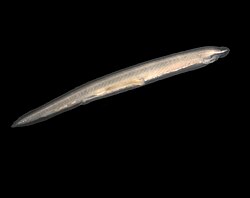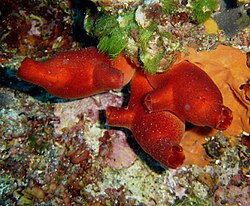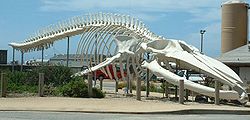Chordate
| Chordates | |
|---|---|
| Scientific classification | |
| Kingdom: | Animalia |
| Subkingdom: | Eumetazoa |
| Clade: | ParaHoxozoa |
| Clade: | Bilateria |
| Clade: | Nephrozoa |
| Superphylum: | Deuterostomia |
| Phylum: | Chordata Haeckel, 1874[3][4] |
| Subgroups | |
And see text | |
Chordates, phylum Chordata, are a phylum of animals which have a notochord. The group includes vertebrates, with some closely related invertebrates.
Classification
Taxonomy
- Phylum Chordata
- Tunicata – (tunicates, formerly Urochordata; 3,000 species)
- †Vetulicolia (8 Cambrian species of fossil)
- Cephalochordata – (lancelets, 30 species)
- Vertebrata (vertebrates – animals with backbones; 57,739 species)
- Agnatha (jawless vertebrates; 100+ species)
- Myxini or Hyperotreti (hagfish; 65 species)
- Conodonta (Conodonts)
- Hyperoartia (Lampreys)
- †Cephalaspidomorphi (Paleozoic jawless fish)
- †Pteraspidomorphi (Paleozoic jawless fish)
- Gnathostomata (jawed vertebrates)
- †Placodermi (Paleozoic armoured forms)
- Chondrichthyes (cartilaginous fish; 300+ species)
- †Acanthodii (Paleozoic "spiny sharks")
- Osteichthyes (bony fishes; 30,000+ species)
- Actinopterygii (ray-finned fish; about 30,000 species)
- Sarcopterygii (lobe-finned fish)
- Tetrapoda (four-legged vertebrates; 18,000+ species)
- Agnatha (jawless vertebrates; 100+ species)
Phylogeny
| Chordata |
| ||||||||||||||||||||||||||||||||||||||||||||||||||||||||||||||||||||||||||||||||||||||||||
Note: Lines show likely evolutionary relationships. Extinct groups are marked with a "†". Extinct animals are ones that have completely died out.
Origin of chordates
According to a long-standing theory, the origin of chordates may be found in transformed larvae of sea-squirts (tunicates). Adult tunicates are sessile, but their larvae are motile, and have some features found in early vertebrates. The process of paedomorphosis, where juvenile features are retained in the adult, is the proposed mechanism.[8][9][10] Genome analysis shows that tunicates are the closest living relatives of vertebrates.[11]
Chordate Media
The glass catfish (Kryptopterus vitreolus) is one of the few chordates with a visible backbone. The spinal cord is housed within its backbone.
Cephalochordate: lancelet. Pictured species: Branchiostoma lanceolatum
Haikouichthys, from about 518 million years ago in China, may be the earliest known fish.
A skeleton of the blue whale, the largest animal, extant or extinct, ever discovered. Mounted outside the Long Marine Laboratory at the University of California, Santa Cruz. The largest blue whale ever reliably recorded measured 98ft (30m) long.
A peregrine falcon, the world's fastest animal. Peregrines use gravity and aerodynamics to achieve their top speed of around 242mph (390km/h), as opposed to locomotion.
References
- ↑ "Wikipedia, the free encyclopedia". www.wikipedia.org. Retrieved 2025-08-08.
- ↑ Fedonkin, M. A.; Vickers-Rich, P.; Swalla, B. J.; Trusler, P.; Hall, M. (2012). "A new metazoan from the Vendian of the White Sea, Russia, with possible affinities to the ascidians". Paleontological Journal. 46 (1): 1–11. Bibcode:2012PalJ...46....1F. doi:10.1134/S0031030112010042. S2CID 128415270.
- ↑ Haeckel, E. (1874). Anthropogenie oder Entwicklungsgeschichte des Menschen. Leipzig: Engelmann.
- ↑ Nielsen, C. (July 2012). "The authorship of higher chordate taxa". Zoologica Scripta. 41 (4): 435–436. doi:10.1111/j.1463-6409.2012.00536.x. S2CID 83266247.
- ↑ 5.0 5.1 He, K.; Liu, J.; Han, J.; Ou, Q.; Chen, A.; Zhang, Z.; Fu, D.; Hua, H.; Zhang, X.; Shu, D. (2023). "Comment on "Ultrastructure reveals ancestral vertebrate pharyngeal skeleton in yunnanozoans"". Science. 381 (6656): eade9707. doi:10.1126/science.ade9707. PMID 37499008.
{{cite journal}}: Check|pmid=value (help) - ↑ Mussini, G.; Smith, M. P.; Vinther, J.; Rahman, I. A.; Murdock, D. J. E.; Harper, D. A. T.; Dunn, F. S. (2024). "A new interpretation of Pikaia reveals the origins of the chordate body plan". Current Biology. 34 (13): 2980–2989.e2. Bibcode:2024CBio...34.2980M. doi:10.1016/j.cub.2024.05.026. PMID 38866005.
{{cite journal}}: Check|pmid=value (help) - ↑ 7.0 7.1 Lerosey-Aubril, R.; Ortega-Hernández, J. (2024). "A long-headed Cambrian soft-bodied vertebrate from the American Great Basin region". Royal Society Open Science. 11 (7). Bibcode:2024RSOS...1140350L. doi:10.1098/rsos.240350. PMC 11267725. PMID 39050723.
{{cite journal}}: Check|pmc=value (help); Check|pmid=value (help) - ↑ Garstang, Walter 1894. Preliminary notes on a new theory of the phylogeny of the chordates. Zoologischer Anzeiger 17, p122.
- ↑ Garstang, Walter 1928. The morphology of the tunicata, and its bearing on the phylogeny of the Chordata. Quarterly Journal of Microscopical Science 72, p51.
- ↑ de Beer, Gavin 1951. Embryos and ancestors. 3rd ed, Oxfor, The evolution of chordates, p76.
- ↑ Delsuc, Frédéric et al. 2006. Tunicates and not cephalochordates are the closest living relatives of vertebrates. Nature 439, 965-968
Other websites
| Wikispecies has information on: Chordata. |
- Chordate node at Tree Of Life Archived 2007-02-24 at the Wayback Machine
- Chordate node at NCBI Taxonomy









